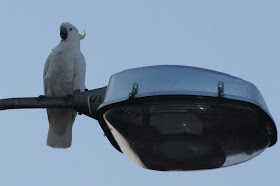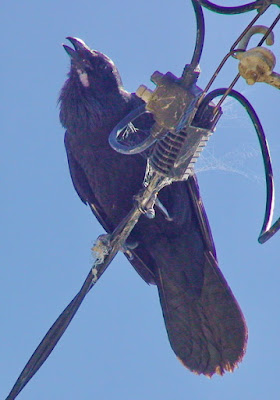I visited my old stomping ground, the Australian Museum - much changed, of course. For one thing, this fuzzy and appealing model of Diprotodon, the long-extinct giant wombat relative that once roamed the interior in vast herds, is a new arrival since my day.
This is a nature blog, not an emotional journal (as hard as it might be to distinguish the two at times), so having made the point that Sydney is far more than just another travel destination for me I will move on to my encounters (re-encouters, really) with the city's wildlife. I didn't have far to go to find it: Eileen and I stayed with her old classmate Rita in Eastwood, where Crested Pigeons (Ocyphaps lophotes) were dooryard birds.
Though it is hardly a kangaroo or a koala, the Crested Pigeon is a quite satisfactory symbol of the uniqueness of Australia's wildlife. In Australia, the birds and mammals (and, in part other wildlife as well) that fill various ecological roles in other parts of the world are frequently replaced by similar-looking (or acting), but quite different, creatures. This is familiar for mammals: there are marsupial equivalents here for creatures from moles to flying squirrels (not to mention, in the absence of genuine anteaters, two quite unrelated anteater equivalents, one a marsupial and the other an egg-laying monotreme).
It happens for birds, too. Australia lacks pheasants (aside from a few tiny quail), but it has a number of more or less pheasant-like pigeons. The Crested Pigeon is hardly the most extreme example - I don't think anyone would mistake it for anything but a pigeon of some sort - but it will do. It's very pretty, too.
Birds were not the only Australian wildlife at Rita's door; here, for example, is a Fence Skink (Cryptoblepharus virgatus) on her garden wall.
From Rita's back porch I could watch the most gorgeous dooryard bird in the world: the Rainbow Lorikeet (Trichoglossus haematodus). In the years since I lived in Sydney, Rainbow Lorikeets have greatly increased their numbers in the city precincts. Perhaps surprisingly (who, it would seem, could resist such a brilliant creature?), not everyone is happy about that; the lorikeets are beautiful to look at, yes, but their harsh screeching voices are not to everyone's ear.
Lorikeets are a particularly Australasian group of parrots, with a specialized diet of nectar and pollen and a brush-tipped tongue to scoop it up. The combination of spectacular parrots nibbling on beautiful flowers can be sensually overwhelming at times!
Australia has a higher proportion of nectar-feeding birds than perhaps any other continent, perhaps because its dominant trees, the eucalypts, are bird-pollinated. In addition to the lories and lorikeets, there are some fifty species of Australian honeyeaters (Meliphagidae). In Sydney, though, one dominates: the Noisy Miner (Manorina melanocephala). It is, I'm afraid, something of an ornithological villain.
Miners have exploded in urban Australia. Unfortunately, they are extremely aggressive, driving any other birds they can bully out of their territory. The result, for someone who has been away from Australia for over three decades, is shocking. The common small garden birds I used to associate with every park and lawn - fairy wrens, small honeyeaters, Australian flycatchers and the like - have all but vanished. In my walks around bits of urban bush I was hard put to find any bird smaller than a miner.
Bigger birds, like this Australian Magpie (Gymnorhina tibicen), can hold their own quite successfully against the miners - and that can be a problem of its own, for some of these birds - particularly the magpie's close relatives the butcherbirds (Cracticus spp) - are predators and nest robbers. The smaller fry don't stand much of a chance.
One of the most obvious ways that Sydney's urban birdscape has changed has been the influx of Sulphur-crested Cockatoos (Cacatua galerita), possibly bolstered by the release of unwanted pests. They, too, have their detractors; according to Birdlife Australia, "The species has become a pest around urban areas, where it uses its powerful bill to destroy timber decking and panelling on houses."
Rita's house is only a short distance from Terry's Creek, a bit of urban woodland that made for a pleasant morning bird walk.
After so many years of seeing eucalyptus trees in places where they do not belong, it was pleasant indeed to get back to their homeland. This is (I believe) a Sydney Blue Gum (Eucalyptus saligna), one of over 700 species, all but nine of which occur in Australia (only fifteen species range naturally beyond the continent).
Though an exotic eucalypt woodland can be a barren place, in their native range eucalypts play host to a great many animals. The gum trees, like this one, shed their bark in strips that collect in the crotches of limbs, and the insects that hide here are hunted by birds that fly from one clump of bark to another, often ignoring the rest of the tree.
Eucalypt flowers produce copious nectar, food for honeyeaters and lorikeets; here you can glimpse a Musk Lorikeet (Glossopsitta concinna), a far less conspicuous species than its rainbow-hued cousin.
Some Eastwood butterflies: a Common Crow (Euploeia core), above, and below, a rather battered Common Brown (Heteronympha merope). With a few exceptions Australia's butterflies are less distinctive than its vertebrate fauna; many are representatives of genera, like Euploiea, well-known in south-east Asia; the Common Crow itself ranges as far north and west as India, Sri Lanka and Myanmar. The Common Brown, though, is a southern Australian endemic.
Golden orb-weaving spiders also belong to an almost world-wide group; this is either Nephila edulis or N. plumipes.
It was nice to have Terry's Creek to wander through - though obviously its state of preservation doesn't suit everyone!
If any bird can be called characteristic of Australia it must be this one: the Laughing Kookaburra (Dacelo novaeguinae). Eileen was delighted when I showed her one; she had been taught to sing "Kookaburra sits in the old gum tree" in school in Malaysia, without ever having been told precisely what a kookaburra (or, I suspect, a gum tree) actually was. It is, in fact, the world's largest kingfisher, and it can be remarkably bold; this bird was at Taronga Zoo, but it was perfectly wild.
Also at the zoo, a Noisy Miner and a Kookaburra check out the picnic leavings.
Sydney, of course, is wonderfully situated on its glorious harbor, and ferry rides (to the zoo, or elsewhere) are a delightful way to appreciate it. Eileen and I spent one morning riding the ferry outside the harbor mouth to Manly, famous for its sandy beach.
Here we found Silver Gulls (Chroicocephalus novaehollandiae), as ubiquitous as their extremely similar cousin the Red-billed Gull (C. scopulinus) in New Zealand.
The Welcome Swallow (Hirundo neoxena) is widespread in Australia, and has colonized New Zealand in recent decades. These three, resting on the pavement at Manly, seem quite uninterested in a flight across the Tasman.
Australia has five species of crow. They are not easy to tell apart, but fortunately in Sydney there is only one: the Australian Raven (Corvus coronoides), a bird whose mournful wailing call can be quite startling to a birder familiar with the harsh cries of North American crows.
While Eileen indulged in people-watching on the beach, I took a stroll to the nature reserve on the rocky shore along the southern end of the bay.
Part of the reserve's purpose is to protect a population of Eastern Water Dragons (Physignathus l. lesueurii), quite substantial lizards (the male can exceed a metre in length) that have adapted quite well to our presence in parks and gardens.
I found this rather self-satisfied individual sitting directly under the sign in the previous picture. I interpreted his smug expression to mean, "See that sign? You can't touch me, mate - I'm protected!"
After taking a ferry to Manly, Eileen and I decided to take one in the other direction, up the Paramatta arriver that flows into Sydney Harbour.
Sydney is surrounded, in fact, by beautiful country. Near the end of our Australian sojourn we headed north to the Hawkesbury River. My aim here, though, was not to take in the scenery, but to visit an old friend.
Dr. Harry Recher is an American expatriate, a long-time resident of Australia who has contributed a great deal to our knowledge of the ecology of Australian birds. During my time at the Australian Museum, Harry acted as my valued mentor and supervisor, and I was delighted to have a chance to visit him and his wife Judy after so many years. It doesn't hurt that they live in a beautiful spot on an island in the Hawkesbury; Eileen and I had a lovely afternoon at and around their home.
Harry has been extremely concerned about what has been happening to Australia's birds in recent years, including the decline of so many once-common city birds that I mentioned earlier. Harry's short video on the plight of Australia's small birds should be required watching for all readers of this blog - and if you live in Australia, get your friends (and enemies, including politicians) to watch it too.
There are still birds on the Hawkesbury, though their numbers are declining. This tailless Eastern Rosella (Platycercus eximius) flew in to a casuarina tree on the slope below Harry's porch.
High overhead, we saw a few Noisy Friarbirds (Philemon corniculatus), one of the larger honeyeaters - the family to which Harry has devoted much of his research.
Even this bird, though, was in trouble; the last I saw of it it was being pursued by a predator, a Grey Butcherbird (Cracticus torquatus); I can only hope that I did not, in my eagerness to see and photograph the fantail, draw the butcherbird's attention. And, of course, I hope the fantail got away!











































